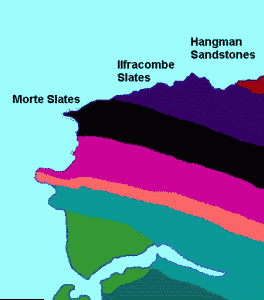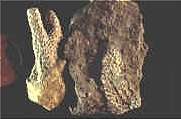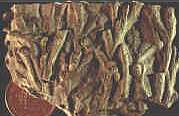
The surface geology of north Devon is represented by a series of parallel bands of rock running roughly north-west to south-east (left). Hele is on the middle of the Ilfracombe Slates and is bordered to the east by the older Hangman Sandstone's and to the west by the younger Morte Slates. The eastern border runs along the eastern side of the valley of Combe Martin, the western border runs parallel from the coast at Lee Bay (1).
These sedimentary rocks were originally formed about 400 million years ago, mostly from mud and sand, with thin layers of limestone made from small coral reefs. North Devon then had a tropical desert climate and was under the sea just off a large continent south of the equator. About 300 million years ago the rocks were lifted and folded to form a chain of mountains to the north which may once have been as high as the Himalayas. In Hele the rocks slope down to the south by around 45 degrees; this can be seen quite clearly on Hele Beach (2).


A layer of limestone about 15’ wide, lying nearly vertical, runs across the headlands of Rillage and Hillsborough. This was extensively quarried in the 19th century, particularly at Samson’s Beach and Joe Moon’s, for limeburning. The Rillage limestone is well known for its fossilised corals (right) which date from very early in the development of life on earth, when the first fish with vertebrates were beginning to appear (3).
A characteristic of the cliffs on Hele and Haggington Beach are long thin streaks of white quartz that were forced between the layers of rock under high pressure, presumably when they were folded. These intrusions are often associated with silver-lead deposits and although it is widely known that there were silver mines in Combe Martin, there are also traces of silver-lead mining around Berrynarbor and on Haggington Beach (4).
(1) Surface geology
Most of the rocks in north Devon are sedimentary. Limestone (also sedimentary, composed of sea creatures) occurs in thin and infrequent layers near Ilfracombe, Saunton Down and Morte Point. Hele is on the Ilfracombe Slates (late formed from sedimentary rock that has undergone stress) between older Hangman Sandstone to the east and younger Morte Slate to the west. All are Devonian (laid down 408-360m years ago). About 300m years ago, towards the end of the Carboniferous, the Devonian rocks were folded and faulted. (Abbott 1991) The drawing above is based on p 14-15.
(2) Formation
Most of the south-west rocks are from the Devonian and Carboniferous 395-280M years ago, the Devonian characterised by Old Red Sandstone's formed under a tropical desert climate when Devon lay at the southern margin of a large continent. Deposits included shale and limestone formed from coral reefs. Many mineral deposits in the south-west were created around 290M years ago, by intrusion of granite basoliths (now Dartmoor and Bodmin Moor), but those in north Devon are thought to be earlier formed by a process not yet fully understood. By 2.4M years ago the surface geology of the south-west was much as today. (Caseldine, CJ, Environmental Setting, in Kain & Ravenhill 1999 p 26)
"About 300 million years ago, the scene was rudely interrupted by great mountain building earth movements. The flat lying Devonian and Carboniferous rocks were squashed, as in a vice, by powerful north south compression which forced the rocks to crack and buckle (fold), like a carpet being rucked up.....veins of white quartz filled cracks in the rocks and are common in places. As a result of these tremendous forces, a chain of mountains rose over South West England. we can only guess at the eventual height of these mountains, but they may have been as high as the Himalayas." (Edwards 2000 p 13)
"This site [Haggington Beach] provides excellent exposures of sandstone's and mudstones of the Ilfracombe Beds, formed during the Middle Devonian (Givetian). Interbedded are thin, but continuous, limestone bands which contain fossil corals and brachiopods, indicating a shallow sea floor palaeoenvironment. The limestone bands are stratigraphically important as marker-horizons, allowing correlation with inland exposures. Large folds formed during the Variscan Orogeny affect the area" (Author unknown, DCC Educational Register of Geological Sites website 2002 www.devon.gov.uk/geo-HSC.pdf)
"The Ilfracombe Beds are exposed between Ilfracombe and Combe Martin as slates with subordinate sandstone's and limestone's. The first attempted stratigraphy by Evans (1922) produced the Lester Slates-and-Sandstones and the Wild Pear Slates. Later Shearman (1962) recognised a three-fold division in the slates, the upper and lower parts characterised by the sandstone's and the middle part containing most of the limestone, incorporating the marker limestone's" (Author unknown, DCC Educational Register of Geological Sites website 2002 www.devon.gov.uk/geo-HSC.pdf)
When most of Exmoor's rocks were forming 350-400 million years ago, the area was lying in the tropics well south of the equator and has since drifted northwards. Many of the rocks were laid as sediments in shallow seas and, at times when there was little sediment being brought to the sea from the neighbouring land, coral reefs grew in the clear, warm waters (Brian Pearce, Exmoor National Park website at [2006] www.exmoor-nationalpark.gov.uk/index/looking_after/looking_after_landscape/geology.htm select fossils )
(3) Corals
"At the NE corner [of Hillsborough], and thence round the hill to Hele Bay the outcrop of limestone is well seen. The beds are of no great thickness, and as a rule pass gradually into the slates on either side of them. In an outlying reef dipping south, there is at present a well-exposed surface of limestone, covered with indistinct traces of organic remains. In Hele Bay the slates afford chrinoids abundantly, and in the next bay, known as Haggington Beach, is probably the best section of the characteristic beds of the Ilfracombe series that can be obtained anywhere. The slates are seen alternatively with limestone's, grits and siliceous bands, whilst fossils are extremely numerous, though in a bad state of preservation, owing to the hardness of the rock in which they are embedded" (Hall 1879 p 280)
"The quarry immediately above the cliff [at Rillage] contains several well known Middle Devonian fossils, especially those surfaces of the limestone which have become ‘weathered’ or partially decomposed by exposure. On the shore beneath...the limestone occurs in a series of ten or a dozen wide rolls, parallel to each other, and looking from a distance not unlike ripple marks on a large scale. West of Rillage is Sampson's Bay, where the outcrop of the Haggington limestone is well shewn, and where there are three caves formed by fissures in the slate; the descent to the beach is remarkable for the number of corals, especially a small variety of Favosites Cervicornis, projecting from the weathered surfaces of the beds." (Hall 1879 p 281)
"To the geologist, indeed, this part of the Devonshire coast is of no little interest.... In Sampson's Cove the boulders on the beach are full of Tentaculites, and in the beds are found the remains of fish. Favosites cervicornis lie in the limestone's of Rillage and Widmouth Head, and the beds about the path leading down to Haggington Beach, to the west of Rillage, contain every fossil form of the district, including "casts of that rare shell Rensellaeria", this being the only locality in Great Britain in which it has been noticed" (Page 1895 p 80)
"The corals found in the limestone's of the Ilfracombe slates suggest that they were formed in fairly shallow warm clear seas. Those rocks that were formed on land - mainly sandstones like the Hangman Sandstone - do not by their nature contain many fossils. A few plant fragments and remains of fish have been found, but they are very rare.....Because they were formed in the sea, the more slaty formations - like the Ilfracombe Slates and Lynton Formation - contain more fossils. These include bivalves, brachiopods and crinoids (sea-lilies). In places they are rather poorly preserved, or have been deformed by the cleavage. In the Ilfracombe Slates, almost all of the fossils have been found in the limestone's, and include especially corals. Apart from the fossil remains of the animals or plants themselves, there are other kinds of 'fossil'. These consist of the traces that the animal has left in the rocks, while the animal itself is not preserved. The best example of this kind of fossil is Chondrites (kon-dry-tees) which is found in the Lynton Formation and also in the Ilfracombe Slates. This trace fossil is mainly found in slates and consists of branching tubes filled with sandstone, probably made by a burrowing worm." (Edwards 2000 p 11-12)
"Most of Exmoor's rocks belong to the Palaeozoic era, the time when it was originally thought that life began on Earth. As a result, the creatures around at the time tended to be small and simple. Many had no hard parts which could later be preserved as fossils. There was little life on land and some Exmoor rocks were formed in lifeless deserts. However, fossils, including some of the earliest fish fossils, can be found in Exmoor rocks. Many are misshapen or fragmented because of the great pressures and shearing of the rocks during earth movements. Of the few that survive, those known as Chondrites are probably the most common. These are known as trace fossils because they are the traces of creatures rather than the creatures themselves which have been preserved. As a result it is difficult to guess what sort of creatures left these marks in the rocks. They used to be called tentaculites, then fucoids because people thought they were fossilised tentacles or seaweeds. Some think they are the droppings of fish but most now think that they are the burrows of worms or crustaceans." (Brian Pearce, Exmoor National Park website at [2006] www.exmoor-nationalpark.gov.uk/index/looking_after/looking_after_landscape/geology.htm select fossils) The pictures of fossils shown above, one of coral and one of chondrites, were taken from the 2002 website and used with the kind permission of Brian Pearce.
"The fossils of the Ilfracombe Beds are, in general, either badly preserved or difficult to separate from the matrix. Since the slates are heavily cleaved, all the fossils are known from the limestone's, which account for only a small part of the formation. The fossils found, such as the coral fauna of the Jenny Start Limestone, indicates a Givetian age. The Rillage Limestone, at the base of the Middle Ilfracombe Beds, contains brachiopods, crinoids, orthocones, bryozoans and algae, together with fish fragments, ostracods and small gastropods and is probably the lateral equivalent of the Holey Limestone, placed with thin limestone's at the top of the Lester Slates-and-Sandstones." (Author unknown, DCC Educational Register of Geological Sites website 2002 www.devon.gov.uk/geo-HSC.pdf)
(4) Silver-lead
"The mineralisation is found in the Ilfracombe Slates. The main ore mineral is galena, a heavy silver-grey lead material. Other minerals include the iron mineral siderite, sphalerite (a shiny black zinc material) and minor amounts of chalcopyrite and pyrite." (Edwards 2000 p 31)
Although it is usually thought that the silver-lead deposits in Combe Martin are all on the east side of the valley, near the eastern edge of the Ilfracombe Slates, there are several silver-lead mines known around Berrynarbor and galena (silver-lead ore) has been found on Broadstrand Beach. Tom Norman's Hole, on Haggington Beach, was almost certainly a silver-lead mine.